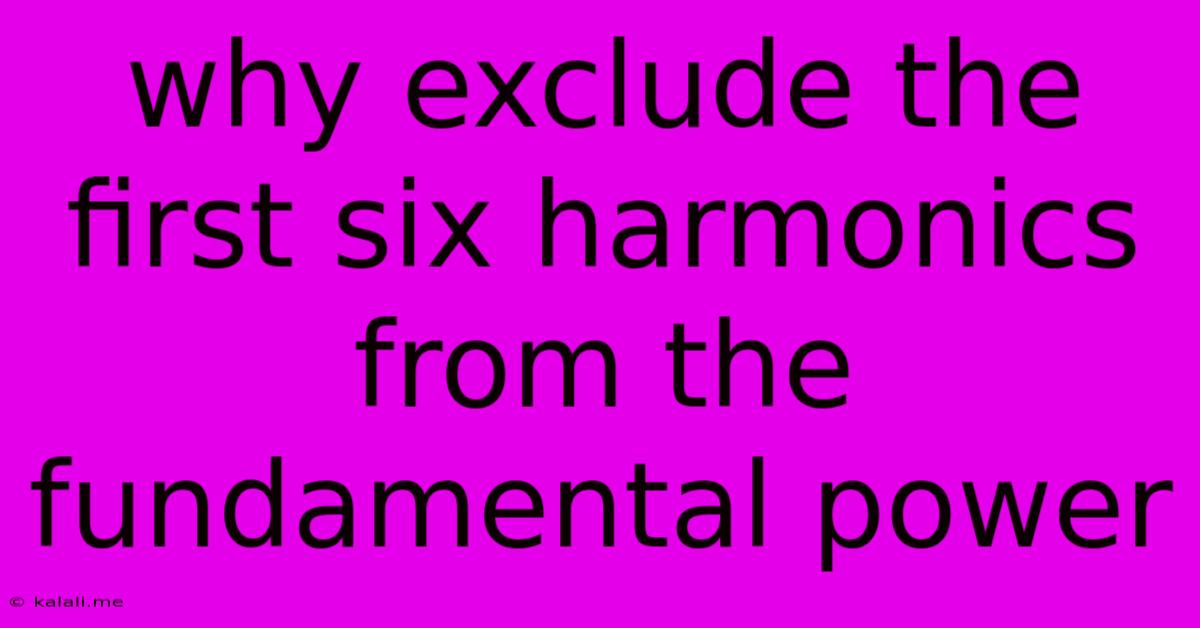Why Exclude The First Six Harmonics From The Fundamental Power
Kalali
May 30, 2025 · 3 min read

Table of Contents
Why Exclude the First Six Harmonics from the Fundamental Power? A Deep Dive into Power Quality
Power quality is paramount in modern electrical systems. Understanding and mitigating harmonic distortion is crucial for ensuring efficient and reliable operation. This article delves into the reasons behind excluding the first six harmonics (specifically the 3rd, 5th, 7th, 9th, 11th, and 13th) from fundamental power calculations and their impact on various electrical equipment. This is essential for electrical engineers, technicians, and anyone interested in maintaining a stable power supply.
The presence of harmonics, multiples of the fundamental frequency (typically 50Hz or 60Hz), distorts the sinusoidal waveform of the power supply. This distortion can lead to significant problems, including overheating of equipment, premature failure of components, and malfunction of sensitive electronics. While all harmonics contribute to distortion, the lower-order harmonics, particularly the first six, are often the most problematic and are therefore the primary focus of mitigation strategies.
The Significance of Lower-Order Harmonics
The first six harmonics hold significant importance due to their prevalence and detrimental effects:
-
Increased RMS Current: Harmonics increase the overall RMS current flowing through the system. This higher current leads to increased losses in conductors, transformers, and other equipment, resulting in wasted energy and potential overheating.
-
Neutral Current Imbalance: Odd-order harmonics, including the 3rd, 5th, 7th, 9th, 11th, and 13th, can significantly increase the neutral current in three-phase systems. This can overload the neutral conductor, causing overheating and potential fires. This is particularly critical in systems with unbalanced loads.
-
Resonance: Harmonics can interact with system impedances, causing resonance. This can lead to amplified harmonic currents and voltages, exacerbating the problems mentioned above. Certain frequencies are more prone to resonant amplification than others, further highlighting the need for selective harmonic mitigation.
-
Equipment Malfunction: Sensitive electronic equipment, such as variable speed drives (VSDs), power supplies, and computers, are particularly vulnerable to harmonic distortion. Harmonics can disrupt their operation, leading to malfunctions, data loss, and premature failure. Power quality monitoring is essential to identify the presence and effects of these harmonics.
-
Capacitor Bank Issues: Harmonic currents can stress and damage power factor correction capacitors, reducing their lifespan and effectiveness. Understanding the harmonic content is essential for proper capacitor selection and protection.
Why Focus on Excluding the First Six?
While higher-order harmonics exist, their individual magnitudes are usually smaller than the lower-order harmonics. The combined effect of the first six harmonics often constitutes the most significant portion of the total harmonic distortion (THD). Therefore, addressing these harmonics directly provides the most impactful improvements in power quality. Strategies focus on mitigating these specific harmonics because they offer the best return on investment in terms of power quality improvement.
Mitigation Techniques
Several techniques are employed to mitigate the impact of these lower-order harmonics:
-
Active Filters: These sophisticated devices actively generate harmonic currents that cancel out the unwanted harmonics, effectively cleaning the power waveform.
-
Passive Filters: These filters use inductors and capacitors to shunt specific harmonic frequencies to ground, reducing their impact on the system. They are often tuned to specific frequencies like the 3rd, 5th, or 7th harmonic.
-
Transformer Selection: Using transformers with appropriate design considerations can mitigate some harmonic effects.
-
Load Balancing: Properly balancing loads in a three-phase system can minimize the impact of odd harmonics on the neutral current.
Conclusion:
Excluding the first six harmonics from fundamental power calculations isn't about ignoring them; it's about focusing on the most significant contributors to power quality issues. By understanding the impact of these harmonics and implementing appropriate mitigation strategies, we can ensure the efficient and reliable operation of our electrical systems, protecting equipment and ensuring stable power supply for various applications. Ongoing monitoring and analysis of harmonic content are key components of effective power quality management.
Latest Posts
Latest Posts
-
Brown Spots Inside Bell Pepper Safe To Eat
Jun 01, 2025
-
Logos Start On A New Line
Jun 01, 2025
-
How To Get A Supplie Id
Jun 01, 2025
-
How Do You Say For In German
Jun 01, 2025
-
I Would Like To Get An Estimate
Jun 01, 2025
Related Post
Thank you for visiting our website which covers about Why Exclude The First Six Harmonics From The Fundamental Power . We hope the information provided has been useful to you. Feel free to contact us if you have any questions or need further assistance. See you next time and don't miss to bookmark.